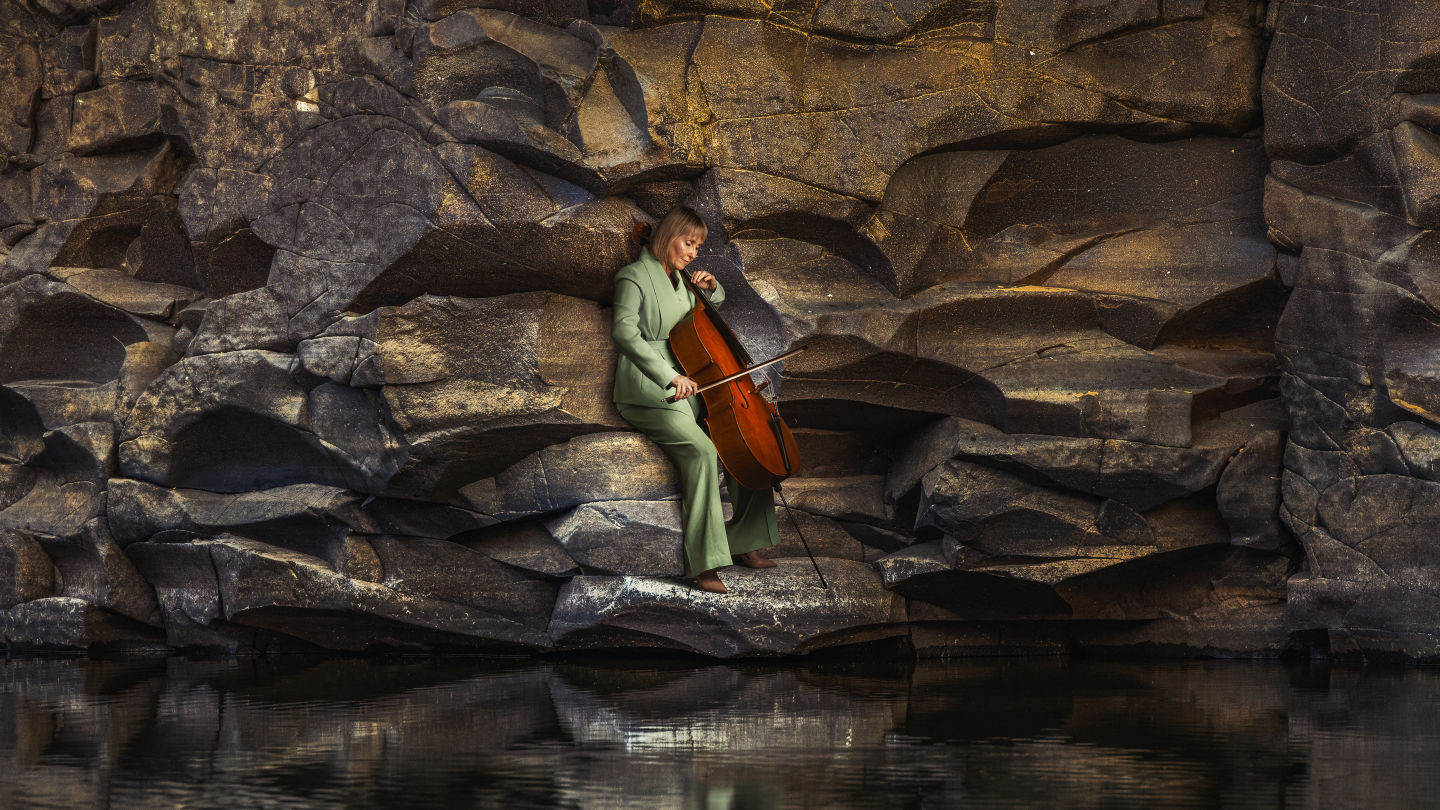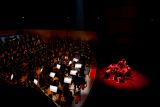Music for Earth Hour
By Alllie Renzetti
Blog ·

This Earth Hour we offer you a moment of reflection. Whether you're planning a long walk, a relaxing bath, or a lie down, we've curated a playlist to accompany your timeout.
Classical music has been inextricably linked to our planet for centuries. Composers have yearned to reflect the natural world in all its glory - from the animals that roam the earth, to the oceans, forests, and mountains they inhabit. More recently, composers have sought to convey the unique climate challenges facing our planet. Much of our 2024 season reflects this.
Spirit of the Wild, mvt 1
Nigel Westlake
In 2016, Australian composer and musician, Nigel Westlake was invited by Australian environmentalist, Bob Brown to join a small group (including Australian pianist, Michael Kieran Harvey) on a boat trip out to the Breaksea Islands on the South West Coast of Tasmania. (Carey, 2017) This land and sea is protected by the Tasmanian Wilderness World Heritage Area and home to the Needwonnee people (Goldrick, 2020). This trip reminded him of how precious the wilderness is and how quickly humankind can sometimes neglect our connection to county, only validating elements of our environment that can make us money. (Editors of the Australian Music Centre, 2017). Nigel collaborated to create this piece with Australian oboist Diana Doherty, who will perform it as part of our concert of the same name, Spirit of the Wild later this year.
Spirit of the Wild
Fri 13 Sep 11.30am + Sat 14 Sep 7.30pm
Concert Hall, QPAC
The Evergreen, mvt 4 Root
Caroline Shaw
Released in 2022, Evergreen explores the relationship between contemporary classical music has with language, narrative and nature. Root is the fourth and final movement with earlier movements titled Moss, Stem and Water. Each movement is a unique ode to nature. Root is depicted by a cello quartet with a rocking, anchored melody. This work proves that music can be just as descriptive as literature. We will perform another of Caroline Shaw’s works, and the Swallow in The Lost Birds
The Lost Birds
Sat 8 Jun 7.30pm + Sun 9 Jun 11.30am
Concert Hall, QPAC
The Creation, mvt 1 - The Depiction of Chaos
Josef Hadyn
This piece was written in 1797-8 by Austrian composer, Joseph Haydn. It is an oratorio - a large-scale musical composition for solo voices, chorus and orchestra. Haydn used the score to evoke the creation of the world as told in the book of Genesis. The first movement - The Depiction of Chaos - immediately arrests the listener. The mood is hushed with shifting, ambiguous harmonies on muted strings, brass and timpani. The soloist sings 'the earth was without form, and void’ and this is reflected in the emptiness of the orchestral accompaniment. Musically there is a sense of stillness until ‘there was light’, when suddenly the orchestra erupts into full volume. Our musicians will be performing The Depiction of Chaos in Spirit of the Wild.
Spirit of the Wild
Fri 13 Sep 11.30am + Sat 14 Sep 7.30pm
Concert Hall, QPAC
Earth Cry
Peter Sculthorpe
Earth Cry is widely hailed as an authentic voice of this country. The piece encourages listeners to pay attention cry of the earth as the First Nations peoples have done for many thousands of years. In his childhood, Sculthorpe was introduced to the work of Norma Davis, one of Tasmania’s early wilderness poets. She had written a poem called Earth Cry, which Sculthorpe has noted partially inspired his composition. Soloist William Barton has had a relationship with QSO for the last 25 years, first performing with the Orchestra when he was 17 years old. William will next perform with us in Dreams and Stories.
Dreams & Stories
Sun 18 Aug 11.30am
Concert Hall, QPAC
The Hebrides (Fingal's Cave)
Felix Mendelssohn
Just like Westlake's Spirit of the Wild, this piece was inspired by various nature trips where composer Felix Mendelssohn learned to appreciate the wild forces of nature. He took trips to the British Isles and explored a sea cave known as Fingal’s Cave. The landscape was very different from where he grew up and you can hear the misty scenery, crashing waves and powerful surge of the ocean in his melodies. You can hear The Hebrides (Fingal’s Cave) performed in The Lost Birds later this year.
The Lost Birds
Sat 8 Jun 7.30pm + Sun 9 Jun 11.30am
Concert Hall, QPAC
Symphony No.8 (Pastoral)
Ludwig van Beethoven
Often described as an 'ode to nature', with the strings section playing a motif that imitates flowing water. Within the score, Beethoven even notated which birds each wind instrument represents; the flute represents a nightingale, the oboe represents a quail and two clarinets represent a cuckoo. Later on in the piece, cello, double basses, and timpani represent distant thunder, piccolo represents lightning, the strings represent high winds and a solo flute evokes a rainbow after the storm.
La Mer, mvt 2 - Play of the Waves
Debussy
A fun fact about this piece of music is that composer, Claude Debussy, looked at paintings and read books about the ocean while he was composing it, instead of visiting the seaside. Debussy describes the movements in La Mer as '3 symphonic sketches', deliberately avoiding the terms 'symphony', 'symphonic poem' or 'movement'. The sea is depicted in a unique way, compared to how other composers have captured it. You can almost feel and hear the swell, splash and crash of the waves when you listen, as a sort of musical onomatopoeia.
References
Bua, J. (2022). Evergreen – Albums. Pitchfork.
https://pitchfork.com/reviews/albums/caroline-shaw-attica-quartet-evergreen/
Carpenter, S. (2024). Mendelssohn Overture – The Hebrides. Mendelssohn in Scotland.
https://www.mendelssohninscotland.com/hebrides-overture
Carey, P. (2017). How Bob Brown and Tasmania’s beauty inspired a concerto - The Music Show, ABC RN.
https://www.abc.net.au/news/2017-02-18/music-nature-two-way-street-how-bob-brown-inspired-a-concerto/8280120
Editors of the Australian Music Centre. (2017). Spirit of the Wild: Chamber concerto for oboe, piano, string quartet and double bass.
https://www.australianmusiccentre.com.au/workversion/westlake-nigel-spirit-of-the-wild/33238
Editors of Encyclopaedia Britannica. (2009) Oratorio - Music Theory & Compositions. Britannica.
https://www.britannica.com/art/oratorio
Goldrick, C. (2020). Finding Freedom in Tassie’s coastal wilderness, Australian Geographic.
https://www.australiangeographic.com.au/travel/travel-destinations/2020/11/finding-freedom-in-tassies-coastal-wilderness/
Huscher, P. (2000). La Mer Program Notes – Chicago Symphony Orchestra. Wayback Machine.
https://web.archive.org/web/20100620224545/https://cso.org/uploadedFiles/1_Tickets_and_Events/Program_Notes/050610_ProgramNotes_Debussy_Mer.pdf
Lee, T. (2022). 2023 Grammy Nominations: See the Complete Winners & Nominees List – Classical.
Grammy Awards.
https://www.grammy.com/news/2023-grammy-nominations-complete-winners-nominees-list
McLellan, J. (1986). Haydn’s Genius Explored. The Washington Post.
https://www.washingtonpost.com...
Potter, C. (2007). Debussy and Nature. The Cambridge Companion to Debussy. Simon Trezise (ed). Cambridge: Cambridge University Press.
Sculthorpe, P. (1986). Earth Cry Programme Notes – Adelaide Symphony Orchestra. Faber Music.
https://www.fabermusic.com/music/earth-cry-928
Sculthorpe, P. (2000/2006). Requiem. ABC Classics. CD. Liner notes
Schwarm, B. (2013). The Creation work by Haydn - Music Theory & Compositions. Britannica.
https://www.britannica.com/top...
Schwarm, B. (2013). The Herbrides, Op. 26: Overture by Mendelssohn - Music Theory & Compositions.
Britannica. https://www.britannica.com/topic/The-Hebrides-Op-26
Trezise, Simon (1994). Debussy: La mer. Cambridge: Cambridge University Press.
Tin, C (2022). The Lost Birds: An Extinction Elegy. Decca Classics. Liner notes.
Whittington, S. (1986). Earth Cry - Arts Reviews. The Advertiser (Australia). 23 August



